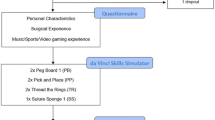Abstract
Objective
This abstract profiles the comparison of correlations between previously validated Super Monkey Ball (SMB) and recently introduced Underground (U) video game on the Nintendo Wii U to multiple validated tasks used for developing basic and advanced laparoscopic skills.
Methods
Sixty-eight participants, 53 residents and 15 attending surgeons, performed the Top Gun Pea Drop, FLS Peg Pass, intracorporeal suturing, and two video games (SMB and U). SMB is an over-the-counter game, and U was formulated for laparoscopic skill training.
Results
Spearman’s rank correlations were performed looking at performance comparing the three validated laparoscopic training tasks, and SMB/U. The SMB score had a moderate correlation with intracorporeal suturing (ρ = 0.39, p < 0.01), and the final score involving all three tasks (ρ = 0.39, p < 0.01), but low correlations with Pea Drop Drill and FLS Peg Transfer (ρ = 0.11, 0.18, p < 0.01). The U score had a small correlation with intracorporeal suturing and final score (ρ = 0.09, 0.13, p < 0.01). However, there were correlations between U score and Pea Drop Drill, and FLS Peg Transfer (ρ = 0.24, 0.27, p < 0.01, respectively).
Conclusion
In this study, SMB had a very significant correlation with intracorporeal suturing. U demonstrated more of a correlation with basic skills. At this point, our conclusion would be that both are effective for laparoscopic skill training, and they should be used in tandem rather than alone.
Similar content being viewed by others
References
CoGM E. Physician Workforce Policy Guidelines for the U.S. for 2000–2020. U.S. Department of Health and Human Services. 2005
Lynge DC, Larson EH, Thompson MJ, Rosenblatt RA, Hart LG (2008) A longitudinal analysis of the general surgery workforce in the United States, 1981–2005. Archives of surgery (Chicago, Ill.:1960) 143(4):345–350 (discussion 351)
AAMC. Center for Workforce Studies, June 2010 Analysis. 2010
Iglehart JK (2013) The residency mismatch. N Engl J Med 369(4):297–299
Program NRM. Results and Data: 2014 Main Residency Match. 2014. http://www.nrmp.org/wp-content/uploads/2014/04/Main-Match-Results-and-Data-2014.pdf
Fonseca AL, Reddy V, Longo WE, Gusberg RJ (2014) Graduating general surgery resident operative confidence: perspective from a national survey. J Surg Res 190(2):419–428
Kothari SN, Ponce J (2014) Issues with “issues in general surgery residency training-2012”. Ann Surg 261(4):e113. doi:10.1097/SLA.0000000000000501
Shetty S, Zevin B, Grantcharov TP, Roberts KE, Duffy AJ (2014) Perceptions, training experiences, and preferences of surgical residents toward laparoscopic simulation training: a resident survey. J Surg Educ 71(5):727–733
Jalink MB, Goris J, Heineman E, Pierie JP, ten Cate Hoedemaker HO (2014) The effects of video games on laparoscopic simulator skills. Am J Surg 208(1):151–156
Rosser JC Jr, Lynch PJ, Cuddihy L, Gentile DA, Klonsky J, Merrell R (2007) The impact of video games on training surgeons in the 21st century. Arch Surg (Chicago, Ill.:1960) 142(2):181–186 (discussion 186)
Badurdeen S, Abdul-Samad O, Story G, Wilson C, Down S, Harris A (2010) Nintendo Wii video-gaming ability predicts laparoscopic skill. Surg Endosc 24(8):1824–1828
Schlickum MK, Hedman L, Enochsson L, Kjellin A, Fellander-Tsai L (2009) Systematic video game training in surgical novices improves performance in virtual reality endoscopic surgical simulators: a prospective randomized study. World J Surg 33(11):2360–2367
Rosser JC Jr, Gentile DA, Hanigan K, Danner OK (2012) The effect of video game “warm-up” on performance of laparoscopic surgery tasks. JSLS J Soc Laparoendosc Surg/Soc Laparoendosc Surg 16(1):3–9
Plerhoples TA, Zak Y, Hernandez-Boussard T, Lau J (2011) Another use of the mobile device: warm-up for laparoscopic surgery. J Surg Res 170(2):185–188
Boyle E, Kennedy AM, Traynor O, Hill AD (2011) Training surgical skills using nonsurgical tasks—Can Nintendo Wii improve surgical performance? J Surg Educ 68(2):148–154
Bokhari R, Bollman-McGregor J, Kahoi K, Smith M, Feinstein A, Ferrara J (2010) Design, development, and validation of a take-home simulator for fundamental laparoscopic skills: using Nintendo Wii for surgical training. Am Surg 76(6):583–586
Adams BJ, Margaron F, Kaplan BJ (2012) Comparing video games and laparoscopic simulators in the development of laparoscopic skills in surgical residents. J Surg Educ 69(6):714–717
Schlickum MK, Hedman L, Enochsson L, Kjellin A, Fellander-Tsai L (2008) Transfer of systematic computer game training in surgical novices on performance in virtual reality image guided surgical simulators. Stud Health Technol Inform 132:210–215
Sadandanan SDV, Sosnowski JP (2008) Video games and laparoscopic surgery. J Gynecol Surg 24:67–73
Goris J, Jalink MB, ten Cate Hoedemaker HO (2014) Training basic laparoscopic skills using a custom-made video game. Perspect Med Educ 3(4):314–318
Jalink MB, Goris J, Heineman E, Pierie JP, ten Cate Hoedemaker HO (2015) Face validity of a Wii U video game for training basic laparoscopic skills. Am J Surg 209(6):1102–1106
Jalink MB, Heineman E, Pierie JP, ten Cate Hoedemaker HO (2015) The effect of a preoperative warm-up with a custom-made Nintendo video game on the performance of laparoscopic surgeons. Surg Endosc 29(8):2284–2290
Cooper MA, Hutfless S, Segev DL, Ibrahim A, Lyu H, Makary MA (2014) Hospital level under-utilization of minimally invasive surgery in the United States: retrospective review. BMJ (Clin Res Ed) 349:g4198
Fader AN, Weise RM, Sinno AK et al (2016) Utilization of minimally invasive surgery in endometrial cancer care: a quality and cost disparity. Obstet Gynecol 127(1):91–100
Ghaderi I, Vaillancourt M, Sroka G et al (2011) Performance of simulated laparoscopic incisional hernia repair correlates with operating room performance. Am J Surg 201(1):40–45
Palter VN, Grantcharov TP (2012) Development and validation of a comprehensive curriculum to teach an advanced minimally invasive procedure: a randomized controlled trial. Ann Surg 256(1):25–32
Author information
Authors and Affiliations
Corresponding author
Ethics declarations
Disclosures
James C. Rosser Jr., Xinwei Liu, Charles Jacobs, Katherine Mia Choi, Maarten B. Jalink, and Henk O. ten Cate Hoedemaker have no conflicts of interest or financial ties to disclose.
Rights and permissions
About this article
Cite this article
Rosser, J.C., Liu, X., Jacobs, C. et al. Impact of Super Monkey Ball and Underground video games on basic and advanced laparoscopic skill training. Surg Endosc 31, 1544–1549 (2017). https://doi.org/10.1007/s00464-016-5059-7
Received:
Accepted:
Published:
Issue Date:
DOI: https://doi.org/10.1007/s00464-016-5059-7




